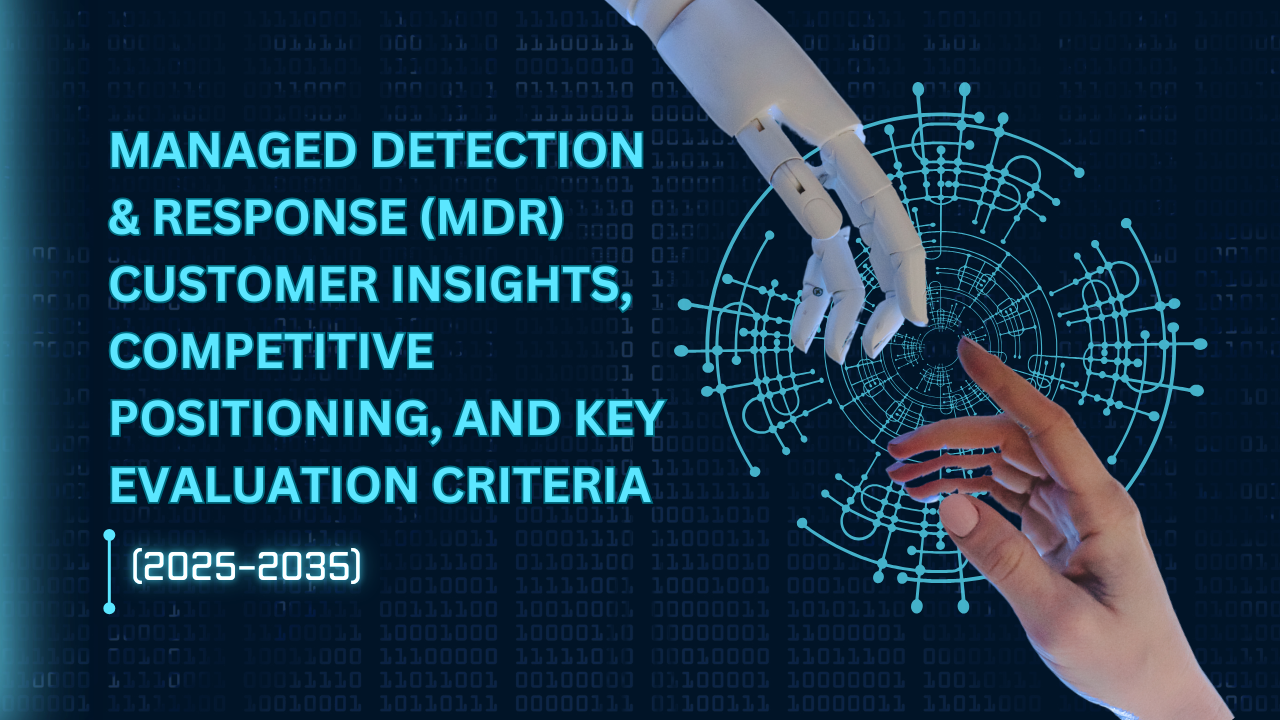1. Executive Summary: The MDR Landscape
-
- Key Finding: 75% of organizations adopting MDR services for 24/7 threat monitoring by 2030
- $25 Billion Opportunity: Growth forecast in the MDR sector by 2035
- Top 5 Competitive Differentiators in the MDR market
2. Introduction
-
- Purpose and scope of the report
- Methodology and data sources
- Target audience and how to use this report
3. Overview of the MDR Market
-
- Definition and scope of MDR services
- Evolution of MDR as a critical cybersecurity solution
- Adoption Trends: Key sectors adopting MDR and market penetration rates (2025-2035)
4. Competitive Positioning of Leading Players
-
- Major Players: Overview of Arctic Wolf, CriticalStart, Deepwatch, eSentire, Expel, Trustwave, etc.
- Market Segmentation:
- Enterprise Focus: How players position themselves to serve large organizations
- SMB Market: Focus on mid-market and smaller businesses
- Technological Differentiation:
- Use of AI and machine learning in threat detection
- Integration of threat intelligence platforms
- Use of automation for incident response
- Service Delivery Models:
- Fully Managed vs. Co-managed vs. Hybrid models
- Geographical reach and customer base analysis
- Industry-specific solutions (healthcare, financial services, government, etc.)
- Competitive Landscape: Market share, key strengths, and areas for improvement for top MDR providers
- SWOT analysis for major players
5. Value Proposition of MDR Solutions
-
- 24/7 Monitoring: How MDR providers help customers maintain continuous security vigilance
- Threat Intelligence and Response:
- Faster response to emerging threats
- Reducing alert fatigue and false positives
- Advanced threat hunting capabilities
- Access to Expertise: Providing skilled cybersecurity professionals to augment internal teams
- Compliance Support:
- How MDR solutions help clients maintain compliance with key regulations (e.g., GDPR, HIPAA, PCI-DSS)
- Cost Efficiency:
- Comparative analysis between in-house SOC (Security Operations Center) vs. outsourced MDR
- Scalability: Ability to adapt to growing business needs and data volumes
6. Key Evaluation Criteria for MDR Solutions
-
- Technical Capabilities:
- Depth of detection across endpoints, networks, and cloud environments
- Integration with existing security tools (SIEM, SOAR, EDR)
- Customizable detection rules and playbooks
- Service Quality:
- Expertise of SOC analysts and threat hunters
- Incident response SLAs (response time, resolution time)
- Quality and granularity of reporting
- Integration and Compatibility:
- Support for hybrid IT environments (on-premises and cloud)
- Ease of integrating MDR into existing security architectures
- Scalability and Flexibility:
- Ability to support growing data and threat complexity
- Flexibility in adapting services to different business environments
- Pricing and Contract Terms:
- Cost structures (flat fee, per device, per volume of data)
- Flexibility of contracts and options for scaling services
- Customer Support and Training:
- Quality of onboarding and training programs
- Ongoing collaboration between internal security teams and MDR providers
- Technical Capabilities:
7. Industry Trends Impacting MDR Selection
-
- Shift Towards XDR (Extended Detection & Response): How MDR providers are evolving into XDR offerings
- AI-Driven MDR Solutions: The rise of artificial intelligence and machine learning in threat detection
- SOAR Integration: How Security Orchestration, Automation, and Response is being leveraged for rapid incident management
- Cloud-Native MDR: Increased focus on cloud-based MDR offerings to support cloud security
- Compliance-Specific MDR: MDR solutions tailored for specific regulatory environments
8. Emerging Technologies in MDR
-
- Behavioral analytics in threat detection
- Zero trust architecture integration
- Blockchain in cybersecurity
- Edge computing and IoT security
9. Challenges in MDR Implementation
-
- Data Privacy and Sovereignty: Challenges in managing sensitive data with MDR providers, especially for global organizations
- Integration with Legacy Systems: How older IT infrastructures can create challenges when implementing MDR
- Balancing Automation and Expertise: Finding the right balance between AI-driven alerts and human expertise
- Measuring ROI:
- Quantifying the return on investment for MDR solutions
- Metrics for success in threat detection and response
10. Best Practices in MDR Vendor Selection
-
- Conducting Proof of Concept (POC):
- Steps to assess the performance of different MDR providers
- How to set up test scenarios for MDR evaluation
- Evaluating Cultural Fit: Ensuring alignment between MDR provider and the organization’s operational culture
- Contract Negotiation:
- Key elements to negotiate in MDR contracts (SLAs, response times, pricing)
- Building long-term relationships for continuous improvement
- Ensuring Vendor Accountability: How to hold MDR vendors accountable for performance and incident handling
- Conducting Proof of Concept (POC):
11. MDR for Specific Industries
-
- Healthcare sector requirements and solutions
- Financial services industry applications
- Government and public sector considerations
- Retail and e-commerce MDR strategies
12. Regulatory Landscape
-
- Impact of evolving cybersecurity regulations on MDR
- Compliance requirements across different regions
- Future regulatory trends affecting MDR adoption
13. Case Studies
-
- Successful MDR implementations across various industries
- Lessons learned and best practices derived from real-world examples
14. Future Outlook for MDR Services (2025-2035)
-
- Technological Advancements:
- How AI/ML and automation will further evolve MDR capabilities
- The role of quantum computing in future cybersecurity threats
- Market Disruptions:
- Emerging players and innovative solutions poised to disrupt the MDR market
- Evolving customer needs and the future of customized MDR solutions
- Predictions for MDR Growth:
- Market growth projections by industry vertical and region
- Increasing reliance on MDR for critical infrastructure and high-risk industries
- Technological Advancements:
15. Conclusion and Recommendations
-
- Key takeaways for decision-makers
- Strategic recommendations for MDR adoption and implementation
16. Appendices
-
- Vendor Selection Checklist
- Additional data tables and charts
- Detailed methodology
- Glossary of Terms
#MDR #CybersecuritySolutions #ThreatMonitoring #24x7Security #AIinCybersecurity #XDR #CloudSecurity #MDRMarketGrowth #QuantumComputing #ThreatDetection #IncidentResponse #SOCvsMDR #AutomationInSecurity #AIThreatHunting #ComplianceSupport #MDRForHealthcare #FinancialServicesMDR #MDRTechnology #CyberThreats #SecurityOrchestration #MDRAdoption





